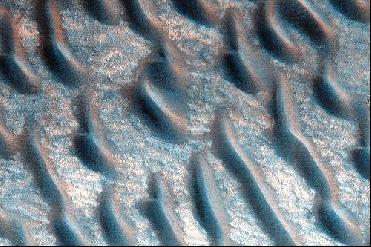
Transverse Dunes in the Northern Lowlands. NASA Photo.
WASHINGTON (BNS): Matt Balme, research scientist with Tucson-based Planetary Science Institute, is leading a team of scientists to decode the Martian mystery landscapes known as Transverse Aeolian Ridges or TARs.
Speaking about the terrain on Mars, Balme said TARs have no exact analog on Earth. These fields of rippled sand, found over large swaths of Mars, are smaller than the planet's gigantic dunes but larger than the sand ripple fields found on Earth, he said.
Balme, who also is a research fellow at Great Britain's Open University and based in Milton Keynes, England, said TARs are worth studying because they are an intriguing scientific mystery, hold clues to past and present climate processes.
“In 2005, NASA's Opportunity Rover got bogged down for six weeks with its wheels firmly stuck in what Balme believes was a small TAR. So it's important to know where TARs are located to avoid landing among them on future rover missions,” he said.
NASA said Balme and his colleagues have conducted a pole-to-pole planet survey of more than 10,000 images taken by the Mars Orbiter Camera, which is flying aboard the Mars Global Surveyor spacecraft.
The team found out that TARs were located in the Southern hemisphere, in an equatorial belt between 30 degrees north and 30 degrees south latitude, in layered terrain or Large Dark Dunes and finally are also abundant in the Meridiani Planum region and in southern-latitude craters.
Explaining the TAR finding Balme said, the Opportunity Rover's TAR encounter provided additional data, showing that TAR was composed of an outer layer of granule-sized material ranging from about 2mm to 5 mm in diameter. Beneath this was a mixed mass of fine and coarse particles.
According to Balme, TARs need two things to form, supply of sediments and strong winds. "The sediment requirement helps explain why they're found near dunes and layered terrain and why they are confined to a central belt around the planet," he said.
"Both dunes and layered terrain (which could have been formed by ancient sand dunes, ocean or lake deposits, or layers of volcanic ash) provide the raw material. Steep slopes also can provide additional particles for TAR formation as they erode. The lack of steep slopes and other sources of coarse and fine material in the middle to far north and south latitudes may explain the absence of TARs in those areas," he said.
The TARs near layered terrain are generally several million years old and inactive, while the ones near LLDs are young and may still be actively forming and moving, he added.
Balme said the very young TARs are found near the Large Dark Dunes, which are also very young, because the sand blowing off the dunes provides the energy needed to form TARs.
"Meanwhile there are areas near layered landforms that used to have active sediment transport, but no longer. This shows a dynamic environment that has changed, and might be able to use TARs as paleo markers to help decipher ancient climates," he said.
The present Martian circulation models don't provide much proof that wind patterns and atmospheric densities on Mars were different in the past than from what they are today. "But I think the geology we are seeing suggests that there might have been different patterns and densities."
"The observations we're getting now from Mars Global Surveyor and the HiRISE camera (flying aboard the Mars Reconnaissance Orbiter) are giving us really good data to drive the models," he said.
Even though the UK scientist and his team have discovered much about TARs, they still don't know what materials the various TAR fields are composed of or even why they're seeing these large features on Mars but not on Earth.
Balme was hopeful that in the next couple of years with the help of images from HiRISE one could decode TARs.
"And they could provide insights into present and past climate patterns as one learns more about them and use that data to help drive general circulation models," he said.
 Previous Article
Previous Article













The Indian Air Force, in its flight trials evaluation report submitted before the Defence Ministry l..
view articleAn insight into the Medium Multi-Role Combat Aircraft competition...
view articleSky enthusiasts can now spot the International Space Station (ISS) commanded by Indian-American astr..
view article